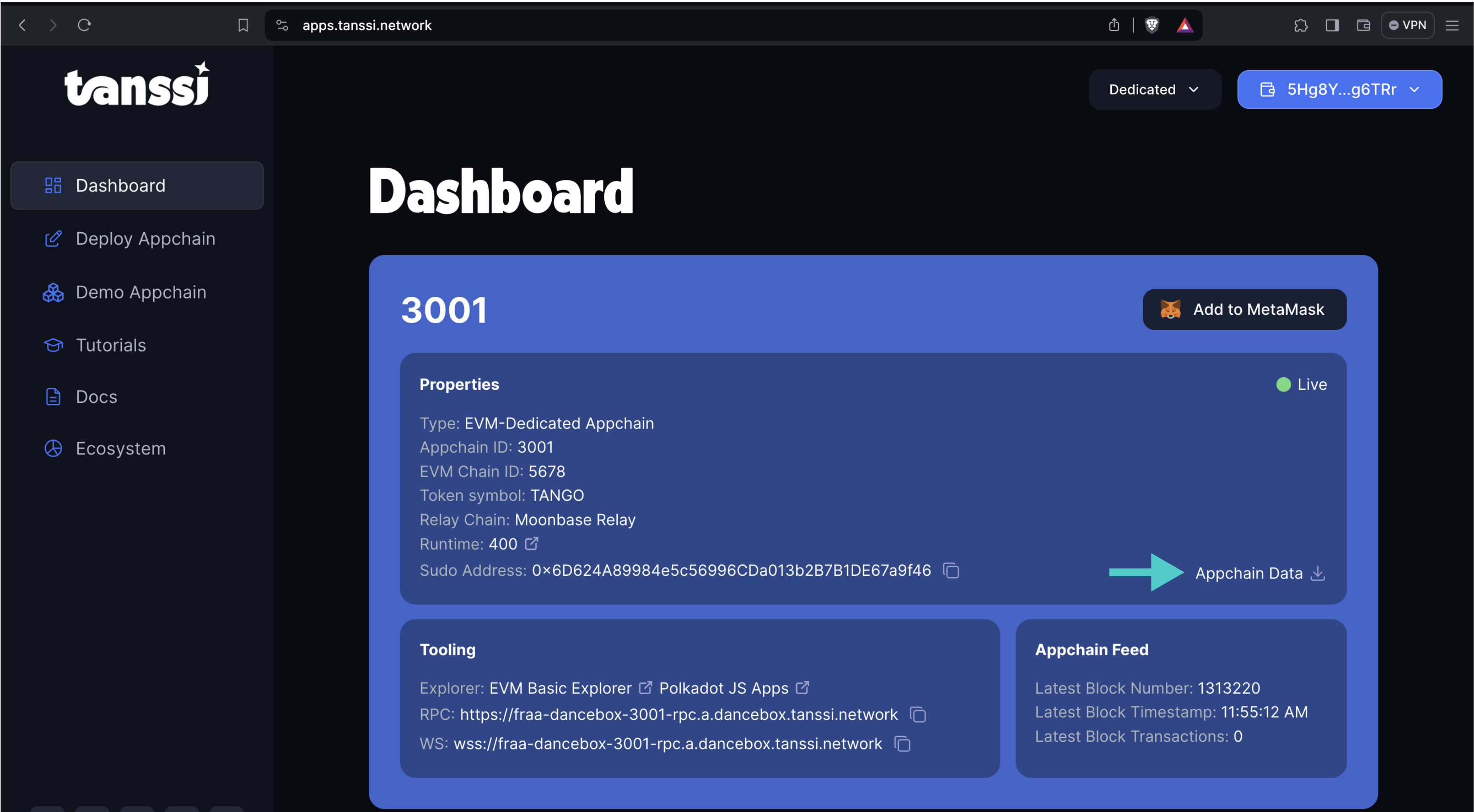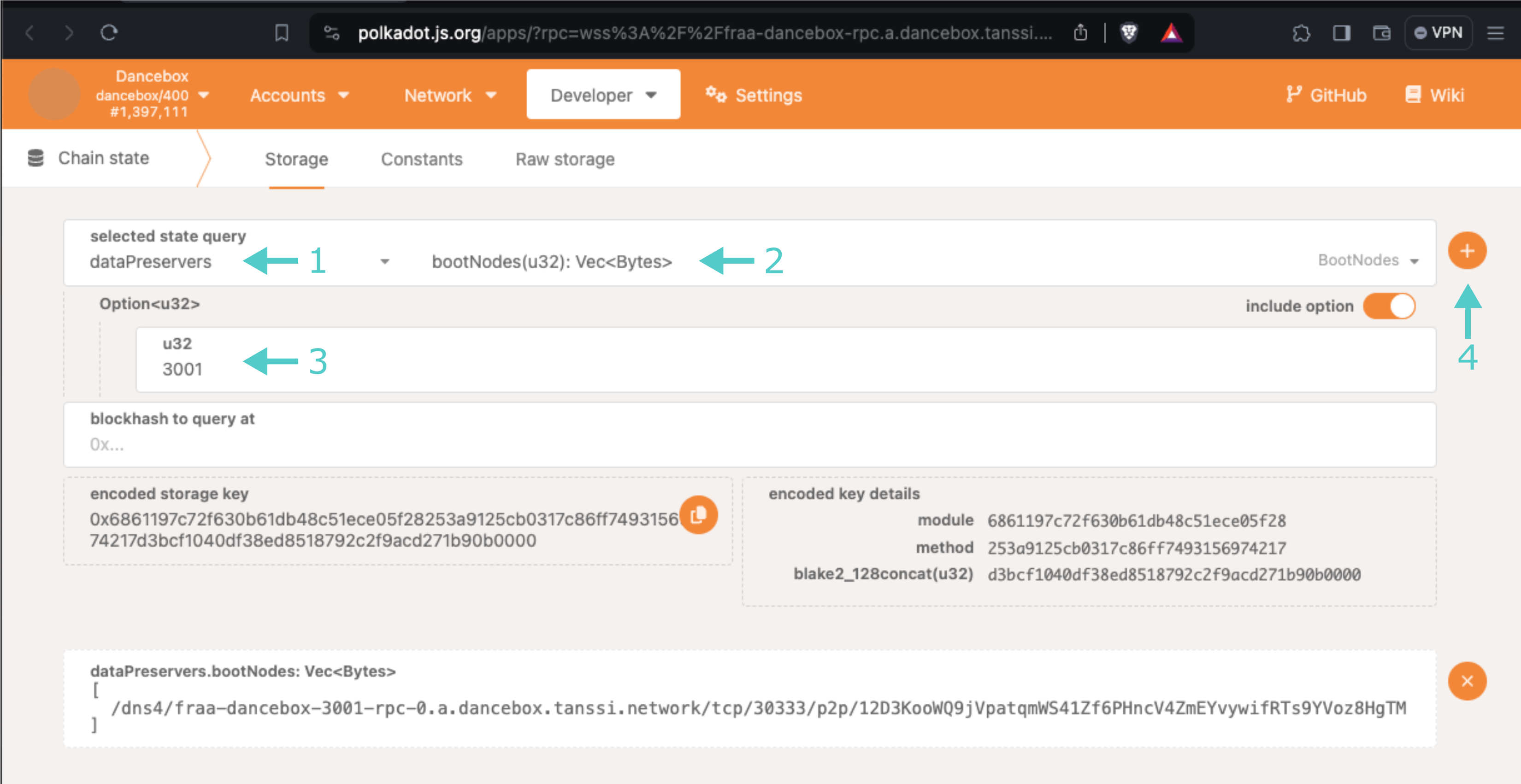Run an Appchain Node Using Docker¶
Introduction¶
Running a Tanssi-powered appchain node allows you to connect to and interact with the appchain using your infrastructure via either HTTP or WebSocket protocols.
Nodes store block data and network state. However, developers can run different kinds of nodes:
-
Full Archive Node - a node storing the entire block data and network state at all block heights. Such nodes are helpful when querying historical data from old blocks. However, a full archive node takes up a lot of space
-
Full Pruned Node - a node storing block data and network state up to some specific number of blocks before the current block height. Such nodes are helpful when querying recent data or submitting transactions through your infrastructure. They require much less space than an archival node but don't store the full network state
In this guide, you'll learn how to quickly spin up a Tanssi appchain node using Docker on a Linux computer. However, it can be adapted to other operating systems.
Note
It is not possible to run an RPC node for quick Trial appchains as they run on a private network, and their nodes are, therefore, unreachable for syncing.
Checking Prerequisites¶
Installing Docker¶
To get started, you'll need access to a computer running a Linux OS and install Docker.
Run the following command to install Docker on a Linux Ubuntu platform:
sudo apt-get install docker-ce docker-ce-cli containerd.io docker-buildx-plugin docker-compose-plugin
And the following command to check the installation:
sudo docker run hello-world
This is what a successful execution in the terminal looks like:
Hello from Docker!
This message shows that your installation appears to be working correctly.
To generate this message, Docker took the following steps:
1. The Docker client contacted the Docker daemon.
2. The Docker daemon pulled the "hello-world" image from the Docker Hub.
(amd64)
3. The Docker daemon created a new container from that image which runs the
executable that produces the output you are currently reading.
4. The Docker daemon streamed that output to the Docker client, which sent it
to your terminal.
To try something more ambitious, you can run an Ubuntu container with:
$ docker run -it ubuntu bash
Share images, automate workflows, and more with a free Docker ID:
https://hub.docker.com/
For more examples and ideas, visit:
https://docs.docker.com/get-started/
Getting Specifications Files¶
An appchain node needs information about two different blockchains to run properly: the appchain and the Tanssi orchestration chain.
That information is a file called chain specifications, and it holds, among other things, the genesis state of the blockchain, allowing the node to verify and sync properly the blocks and state it receives from other nodes.
To get the Tanssi specifications file, execute the following command:
wget https://raw.githubusercontent.com/moondance-labs/tanssi/75e576add204abd321c48cded556c8de14d65618/chains/orchestrator-relays/node/tanssi-relay-service/chain-specs/starlight-raw-specs.json
wget https://raw.githubusercontent.com/moondance-labs/tanssi/75e576add204abd321c48cded556c8de14d65618/chains/orchestrator-relays/node/tanssi-relay-service/chain-specs/dancelight-raw-specs.json
To get the appchain specification file, download it from the dashboard in the dApp by clicking the Network Data link
Setup the Data Directory¶
Running a sequencer or an appchain node require syncing with two chains: the Tanssi orchestration chain and the appchain it is working for.
Run the following command to create the directory where your node will store the databases containing blocks and chain states:
mkdir /var/lib/tanssi-data
mkdir /var/lib/dancelight-data
Set the folder's ownership to the account that will run the Docker image to ensure writing permission:
chown INSERT_DOCKER_USER /var/lib/tanssi-data
chown INSERT_DOCKER_USER /var/lib/dancelight-data
Or run the following command if you want to run the sequencer with the current logged-in user:
sudo chown -R $(id -u):$(id -g) /var/lib/tanssi-data
sudo chown -R $(id -u):$(id -g) /var/lib/dancelight-data
Move the chain specification file to the folder:
mv ./starlight-raw-specs.json /var/lib/tanssi-data
mv ./dancelight-raw-specs.json /var/lib/dancelight-data
Note
The directory is a parameter in the Docker start-up command. If you decide to create the directory elsewhere, update the command accordingly.
Pulling the Docker Image¶
Two Docker images are built and published as part of the automated deployment process for every release: one for EVM-compatible appchains and the other for Substrate appchains.
These Docker images include all the binary files required to run the latest stable release of the client node.
Depending on the type of appchain you want to run the node for, pull the corresponding image.
EVM-Compatible Appchains¶
If the Tanssi-powered appchain was registered in the dApp choosing the EVM template or uploading a custom specification representing a Tanssi EVM-compatible appchain, then execute the following command to pull the Docker image:
docker pull moondancelabs/container-chain-evm-template
docker pull moondancelabs/container-chain-evm-template
The command will download and extract the image and show the status upon execution:
Using default tag: latest
latest: Pulling from moondancelabs/container-chain-evm-template
31ad3619f756: Already exists
8f3d9759dcde: Pull complete
de5eaba9b289: Pull complete
Digest: sha256:4930d631a8ac7f7852754d4cf77bb3317229d768f44092a00295ba50641b2a33
Status: Downloaded newer image for moondancelabs/container-chain-evm-template
docker.io/moondancelabs/container-chain-evm-template:latest
Simple Substrate Appchains¶
If the appchain was registered in the dApp choosing the basic Substrate template or uploading a custom specification file representing a Substrate appchain, then execute the following command to pull the Docker image:
docker pull moondancelabs/container-chain-simple-template
docker pull moondancelabs/container-chain-simple-template
The command will download and extract the image and show the status upon execution, showing a similar output as the previous terminal image.
Start-Up Command¶
To spin up your node, you must run the Docker image with the docker run command. Note that you'll need to modify the following parameters:
Appchain specs file- replaceINSERT_YOUR_APPCHAIN_SPECS_FILEwith your appchain specs file name, downloaded in the Getting Specifications Files step.Bootnode- a bootnode is a full archive node that is used to sync the network from scratch. You'll need to retrieve your Tanssi network bootnode and replaceINSERT_YOUR_NETWORK_BOOTNODESwith the actual bootnode information.
docker run --network="host" -v "/var/lib/tanssi-data:/data" \
-u $(id -u ${USER}):$(id -g ${USER}) \
moondancelabs/container-chain-evm-template \
--chain=INSERT_YOUR_APPCHAIN_SPECS_FILE \
--rpc-port=9944 \
--name=appchain \
--state-pruning=archive \
--blocks-pruning=archive \
--database=paritydb \
--unsafe-rpc-external \
--bootnodes=INSERT_YOUR_NETWORK_BOOTNODES \
-- \
--name=relay \
--chain=/data/starlight-raw-specs.json \
--rpc-port=9945 \
--sync=fast \
--database=paritydb \
--bootnodes=/dns4/deo-tanssi-boot-1.rv.tanssi.network/tcp/30334/p2p/12D3KooWNQ1cddxwvnZZUBG2gtByn9hirVGEn2yR37ztnGSi1VHu \
--bootnodes=/dns4/fro-tanssi-boot-1.rv.tanssi.network/tcp/30334/p2p/12D3KooWS3kv4PyNTxKS8CBxZsVrhMcNcXgxqVUHLrXixuz4DaSR \
--bootnodes=/dns4/qcl-tanssi-boot-1.rv.tanssi.network/tcp/30334/p2p/12D3KooWFDUJ1QZn18tmeJJZU4e6JbyQrLiAp4Xz7ongKzoSjadg \
--bootnodes=/dns4/qco-tanssi-boot-1.rv.tanssi.network/tcp/30334/p2p/12D3KooWBzJzAdAKNVXcsvfL3nHH8BSocNvxz7A8PkRAAJhTuQNm \
--bootnodes=/dns4/uko-tanssi-boot-1.rv.tanssi.network/tcp/30334/p2p/12D3KooWAexWR4uyhVPyxqPBNhhepJ5jRqUa885mu5dKPPVHSfpC
docker run --network="host" -v "/var/lib/tanssi-data:/data" \
-u $(id -u ${USER}):$(id -g ${USER}) \
moondancelabs/container-chain-simple-template \
--chain=INSERT_YOUR_APPCHAIN_SPECS_FILE \
--rpc-port=9944 \
--name=appchain \
--state-pruning=archive \
--blocks-pruning=archive \
--database=paritydb \
--unsafe-rpc-external \
--bootnodes=INSERT_YOUR_NETWORK_BOOTNODES \
-- \
--name=relay \
--chain=/data/starlight-raw-specs.json \
--rpc-port=9945 \
--sync=fast \
--database=paritydb \
--bootnodes=/dns4/deo-tanssi-boot-1.rv.tanssi.network/tcp/30334/p2p/12D3KooWNQ1cddxwvnZZUBG2gtByn9hirVGEn2yR37ztnGSi1VHu \
--bootnodes=/dns4/fro-tanssi-boot-1.rv.tanssi.network/tcp/30334/p2p/12D3KooWS3kv4PyNTxKS8CBxZsVrhMcNcXgxqVUHLrXixuz4DaSR \
--bootnodes=/dns4/qcl-tanssi-boot-1.rv.tanssi.network/tcp/30334/p2p/12D3KooWFDUJ1QZn18tmeJJZU4e6JbyQrLiAp4Xz7ongKzoSjadg \
--bootnodes=/dns4/qco-tanssi-boot-1.rv.tanssi.network/tcp/30334/p2p/12D3KooWBzJzAdAKNVXcsvfL3nHH8BSocNvxz7A8PkRAAJhTuQNm \
--bootnodes=/dns4/uko-tanssi-boot-1.rv.tanssi.network/tcp/30334/p2p/12D3KooWAexWR4uyhVPyxqPBNhhepJ5jRqUa885mu5dKPPVHSfpC
docker run --network="host" -v "/var/lib/dancelight-data:/data" \
-u $(id -u ${USER}):$(id -g ${USER}) \
moondancelabs/container-chain-evm-template \
--chain=INSERT_YOUR_APPCHAIN_SPECS_FILE \
--rpc-port=9944 \
--name=appchain \
--state-pruning=archive \
--blocks-pruning=archive \
--database=paritydb \
--unsafe-rpc-external \
--bootnodes=INSERT_YOUR_NETWORK_BOOTNODES \
-- \
--name=relay \
--chain=/data/dancelight-raw-specs.json \
--rpc-port=9945 \
--sync=fast \
--database=paritydb \
--bootnodes=/dns4/qco-dancelight-boot-1.rv.dancelight.tanssi.network/tcp/30334/p2p/12D3KooWCekAqk5hv2fZprhqVz8povpUKdJEiHSd3MALVDWNPFzY \
--bootnodes=/dns4/qco-dancelight-rpc-1.rv.dancelight.tanssi.network/tcp/30334/p2p/12D3KooWEwhUb3tVR5VhRBEqyH7S5hMpFoGJ9Anf31hGw7gpqoQY \
--bootnodes=/dns4/ukl-dancelight-rpc-1.rv.dancelight.tanssi.network/tcp/30334/p2p/12D3KooWPbVtdaGhcuDTTQ8giTUtGTEcUVWRg8SDWGdJEeYeyZcT
docker run --network="host" -v "/var/lib/dancelight-data:/data" \
-u $(id -u ${USER}):$(id -g ${USER}) \
moondancelabs/container-chain-simple-template \
--chain=INSERT_YOUR_APPCHAIN_SPECS_FILE \
--rpc-port=9944 \
--name=appchain \
--state-pruning=archive \
--blocks-pruning=archive \
--database=paritydb \
--unsafe-rpc-external \
--bootnodes=INSERT_YOUR_NETWORK_BOOTNODES \
-- \
--name=relay \
--chain=/data/dancelight-raw-specs.json \
--rpc-port=9945 \
--sync=fast \
--database=paritydb \
--bootnodes=/dns4/qco-dancelight-boot-1.rv.dancelight.tanssi.network/tcp/30334/p2p/12D3KooWCekAqk5hv2fZprhqVz8povpUKdJEiHSd3MALVDWNPFzY \
--bootnodes=/dns4/qco-dancelight-rpc-1.rv.dancelight.tanssi.network/tcp/30334/p2p/12D3KooWEwhUb3tVR5VhRBEqyH7S5hMpFoGJ9Anf31hGw7gpqoQY \
--bootnodes=/dns4/ukl-dancelight-rpc-1.rv.dancelight.tanssi.network/tcp/30334/p2p/12D3KooWPbVtdaGhcuDTTQ8giTUtGTEcUVWRg8SDWGdJEeYeyZcT
Note
Only the historical state of the last 256 finalized blocks are kept in the local database by default. To run a full archive node, you must set the --state-pruning archive flag. More information is in the flags section.
Fetching Bootnode Information¶
Bootnode information can be read directly from Tanssi itself. For example, you can use the developer portal to get the bootnodes for a specific network in Dancelight.
To do so, take the following steps:
- Select dataPreservers as the module to query
- Set the storage query to bootNodes
- Provide your Tanssi network ID
- Click on the + sign
Full Node Example for Demo EVM Appchain¶
The following example spins up a full archive RPC node for the demo EVM network deployed on Dancelight with an ID of 2001. This example assumes that the specs files were downloaded and are located in the data folder.
docker run --network="host" -v "/var/lib/dancelight-data:/data" \
-u $(id -u ${USER}):$(id -g ${USER}) \
moondancelabs/container-chain-evm-template \
--chain=/data/container-2001-raw-specs.json \
--rpc-port=9944 \
--name=demoAppchain \
--state-pruning=archive \
--blocks-pruning=archive \
--database=paritydb \
--unsafe-rpc-external \
--bootnodes=/dns4/ukl-dancelight-2001-rpc-1.rv.dancelight.tanssi.network/tcp/30333/p2p/12D3KooWKDotMgTRpURvoZHsLWP4K9ymhkBByi1EJjMQAnCmqg8E \
--bootnodes=/dns4/qco-dancelight-2001-rpc-1.rv.dancelight.tanssi.network/tcp/30333/p2p/12D3KooWB3kqqNhYgGtGbsdtgD18wUoFVeuXVXgWLXTFs91RNgAx \
-- \
--chain=/data/dancelight-raw-specs.json \
--rpc-port=9945 \
--name=relay \
--sync=fast \
--database=paritydb \
--bootnodes=/dns4/qco-dancelight-boot-1.rv.dancelight.tanssi.network/tcp/30334/p2p/12D3KooWCekAqk5hv2fZprhqVz8povpUKdJEiHSd3MALVDWNPFzY \
--bootnodes=/dns4/qco-dancelight-rpc-1.rv.dancelight.tanssi.network/tcp/30334/p2p/12D3KooWEwhUb3tVR5VhRBEqyH7S5hMpFoGJ9Anf31hGw7gpqoQY \
--bootnodes=/dns4/ukl-dancelight-rpc-1.rv.dancelight.tanssi.network/tcp/30334/p2p/12D3KooWPbVtdaGhcuDTTQ8giTUtGTEcUVWRg8SDWGdJEeYeyZcT
Run Flags¶
The flags used in the docker run command can be adjusted according to your preferences and hardware configuration. The following ones are some of the most note-worthy:
--name INSERT_NAME- a human-readable name for this node--rpc-port INSERT_PORT- specifies the JSON-RPC TCP port the node listens on--unsafe-rpc-external- exposes the RPC service on all the interfaces--state-pruning INSERT_STATE_PRUNING_TYPE- specifies when the Tanssi-powered network state should be removed from the database. The pruning type can be eitherarchive(which makes the node behave as a full node keeping all the state),archive-canonical(which keeps only the state of finalized blocks), or anynumber(representing the number of blocks whose states are kept)--blocks-pruning INSERT_BLOCKS_PRUNING_TYPE- specifies how many blocks should be kept in the database. The pruning type can be eitherarchive(which makes the node behave as a full node keeping all the blocks),archive-canonical(which keeps only finalized blocks), or anynumber(representing the amount of finalized blocks to keep)--detailed-log-output- enables detailed log output
Warning
The --unsafe-rpc-external enables external access to your node’s RPC interface, making it accessible from any IP address. Make sure that proper security controls are in place.
For a complete list of available flags, their description, and possible values, run the following command:
docker run -ti moondancelabs/container-chain-evm-template --help
docker run -ti moondancelabs/container-chain-simple-template --help
Syncing Your Node¶
Once your node spins up, the syncing process displays a lot of log information from both the node and the Tanssi appchain. Some errors are expected to be displayed at the beginning of the process, disappearing once the chain gets synced to the last block.
2024-02-08 18:30:04.093 INFO tokio-runtime-worker substrate: [Parachain] 💤 Idle (0 peers), best: #0 (0x4a2b…7de3), finalized #0 (0x4a2b…7de3), ⬇ 0 ⬆ 0
2024-02-08 18:30:06.368 INFO tokio-runtime-worker substrate: [Relaychain] ✨ Imported #14139635 (0x8c41…8df6)
2024-02-08 18:30:08.809 INFO tokio-runtime-worker substrate: [Relaychain] 💤 Idle (8 peers), best: #14139635 (0x8c41…8df6), finalized #14139632 (0xa9a8…cab9), ⬇ 32.7kiB/s ⬆
Note
The length of the syncing process is directly proportional to the size of the chain you are syncing to.
| Created: February 10, 2024

